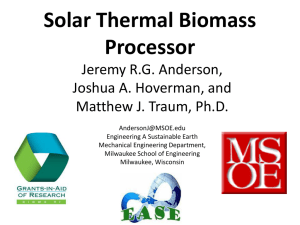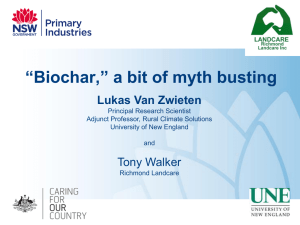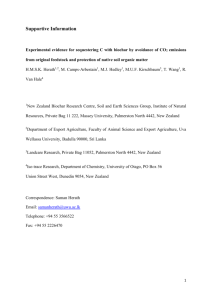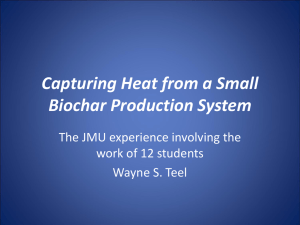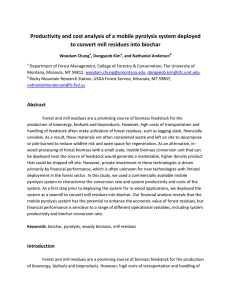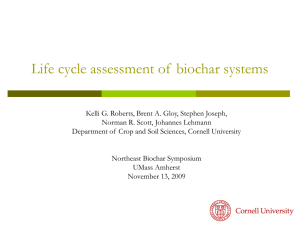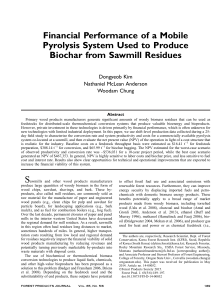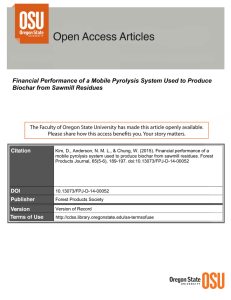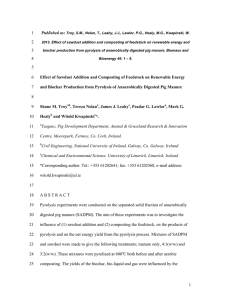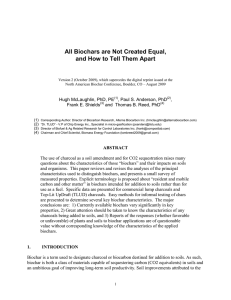gcbb12137-sup-0001-Supplement-material
advertisement
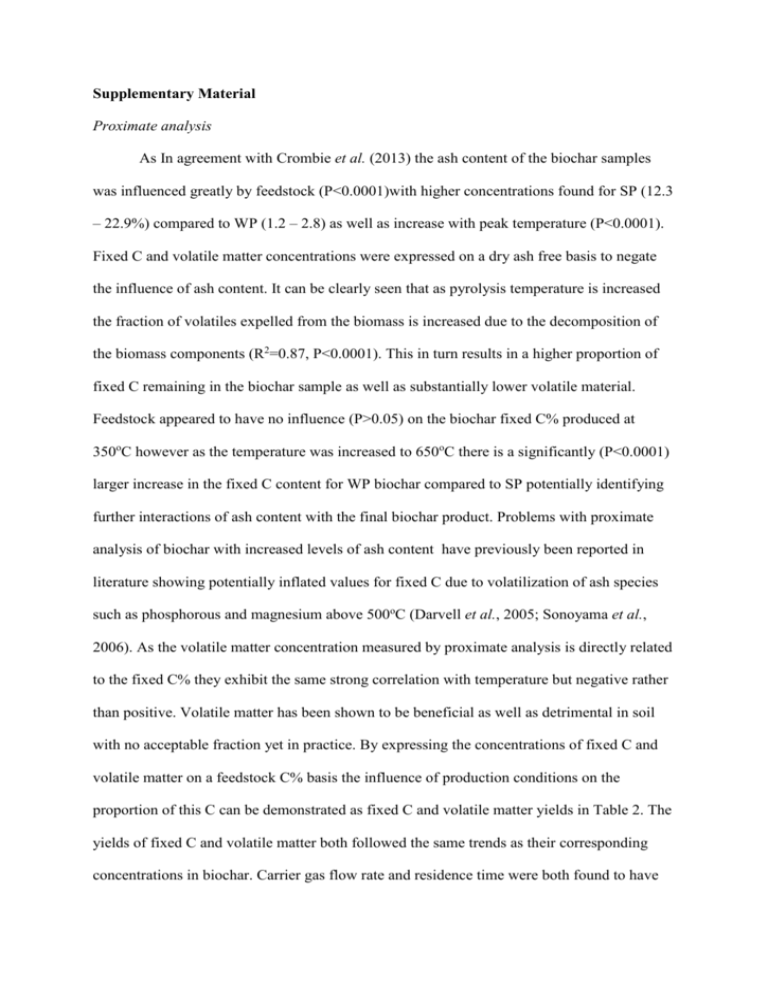
Supplementary Material Proximate analysis As In agreement with Crombie et al. (2013) the ash content of the biochar samples was influenced greatly by feedstock (P<0.0001)with higher concentrations found for SP (12.3 – 22.9%) compared to WP (1.2 – 2.8) as well as increase with peak temperature (P<0.0001). Fixed C and volatile matter concentrations were expressed on a dry ash free basis to negate the influence of ash content. It can be clearly seen that as pyrolysis temperature is increased the fraction of volatiles expelled from the biomass is increased due to the decomposition of the biomass components (R2=0.87, P<0.0001). This in turn results in a higher proportion of fixed C remaining in the biochar sample as well as substantially lower volatile material. Feedstock appeared to have no influence (P>0.05) on the biochar fixed C% produced at 350oC however as the temperature was increased to 650oC there is a significantly (P<0.0001) larger increase in the fixed C content for WP biochar compared to SP potentially identifying further interactions of ash content with the final biochar product. Problems with proximate analysis of biochar with increased levels of ash content have previously been reported in literature showing potentially inflated values for fixed C due to volatilization of ash species such as phosphorous and magnesium above 500oC (Darvell et al., 2005; Sonoyama et al., 2006). As the volatile matter concentration measured by proximate analysis is directly related to the fixed C% they exhibit the same strong correlation with temperature but negative rather than positive. Volatile matter has been shown to be beneficial as well as detrimental in soil with no acceptable fraction yet in practice. By expressing the concentrations of fixed C and volatile matter on a feedstock C% basis the influence of production conditions on the proportion of this C can be demonstrated as fixed C and volatile matter yields in Table 2. The yields of fixed C and volatile matter both followed the same trends as their corresponding concentrations in biochar. Carrier gas flow rate and residence time were both found to have no significant effect (P>0.05) on the biochar concentrations and yields of fixed C and volatile matter at high and low temperatures. Ultimate analysis An increase in pyrolysis temperature resulted in an increase in C content and decreasing H and O concentrations for both types of feedstock and all residence times and carrier gas flow rates. Similar to the trends seen for fixed C and volatile matter, there was a strong correlation (R2=-0.921, P<0.0001) between total C% and volatile matter resulting from the elevated release of volatiles with increasing temperature resulting in a higher proportion of C in the final char product. The elimination of O and H during pyrolysis can be credited to the scission of weak alky-aryl either bonds as well as the attraction of forming increasingly stable compounds (Demirbas, 2004; Mohan et al., 2006). As seen with fixed C there appeared to be a significant influence of feedstock on the total C% with the high ash SP biochar containing a lower amount of C to WP biochar at corresponding temperatures. The concentration of oxygen has long been calculated based on the subtraction of C, H, N and ash from 100%. Due to the inclusion of ash% in this calculation the variation in O appears to be balanced by the lower C for high ash chars producing similar O:C for biochar at corresponding temperatures with no significant influence of feedstock (P<0.05). Unlike biochar total C, the C yield (Feedstock C basis) was seen to be significantly influenced by the residence time (P=0.035) and carrier gas flow rate (P=0.001) in addition to temperature (P<0.0001) and feedstock (P=0.018). The increased pyrolysis temperature resulted in a decreasing C yield due to the coinciding decrease in char yield with rising pyrolysis temperature. Although overall the effect of residence time, carrier gas flow rate and feedstock were deemed to be significant on analysing the data at different pyrolysis temperatures it was found that only feedstock selection and carrier gas flow rate were significant at 350oC whereas at 650oC feedstock, residence time and carrier gas flow rate all had no significant effect on the C yield. This demonstrates that as pyrolysis temperature was increased so did the influence of temperature on the final C yield negating the effect that feed selection, residence time and carrier gas flow rate might have at lower temperatures. The utilisation of elemental ratios has been previously used to give an indication of the long term stability of biochar through the progression of deoxygenation (O:C ratio) and indication of aromaticity (H:C)(Spokas, 2010; IBI Guidelines, 2012; Schmidt et al., 2012; Enders et al., 2012; Crombie et al., 2013). The elemental ratio can also be used to construct a Van Krevelen diagram providing a visual representation of the age and origin of hydrocarbon materials such as coal and petroleum but are more widely being applied to biochar to monitor the evolving composition with temperature (Hammes et al., 2006). The distinct separation of low and high temperature biochars can be seen in Fig. 3 by comparing the H:C and O:C ratios. The overall spread in the sample range diminishes at higher temperatures further demonstrating the dominating influence of temperature at 650oC. Guidelines have been suggested by Spokas (Spokas, 2010), IBI Guidelines (IBI Guidelines, 2012) and European guidelines (Schmidt et al., 2012) for the classification of biochar samples into different categories of stability. Based on these regions of stability it can be seen that the chars produced at 650oC can be viewed as extremely stable whereas only one 350oC char falls within the require guidelines set by Schmidt et al. (2012). References Crombie K, Mašek O, Sohi SP, Brownsort P, Cross A (2013) The effect of pyrolysis conditions on biochar stability as determined by three methods. GCB Bioenergy, 5, 122– 131. Darvell L, Hrycko P, Jones J (2005) Impact of minerals and alkali metals on willow combustion properties. World Renewable Energy …,, 584–589. Demirbas A (2004) Effects of temperature and particle size on bio-char yield from pyrolysis of agricultural residues. Journal of Analytical and Applied Pyrolysis, 72, 243–248. Enders A, Hanley K, Whitman T, Joseph S, Lehmann J (2012) Characterization of biochars to evaluate recalcitrance and agronomic performance. Bioresource technology, 114, 644–53. Hammes K, Smernik RJ, Skjemstad JO, Herzog A, Vogt UF, Schmidt MWI (2006) Synthesis and characterisation of laboratory-charred grass straw (Oryza sativa) and chestnut wood (Castanea sativa) as reference materials for black carbon quantification. Organic Geochemistry, 37, 1629–1633. IBI Guidelines (2012) Guidelines for specifications of biochars for use in Soils. Mohan D, Pittman, CU, Steele PH (2006) Pyrolysis of Wood/Biomass for Bio-oil: A Critical Review. Energy & Fuels, 20, 848–889. Schmidt HP, Abiven S, Kammann C, B. Glaser, Bucheli T, Leifeld J (2012) Guidelines of the European Biochar Certificate. , 1–16. Sonoyama N, Okuno T, Mašek O, Hosokai S (2006) Interparticle desorption and readsorption of alkali and alkaline earth metallic species within a bed of pyrolyzing char from pulverized woody biomass. Energy & Fuels, 20, 1294–1297. Spokas K (2010) Review of the stability of biochar in soils: predictability of O: C molar ratios. Carbon Management, 1, 289–303.

